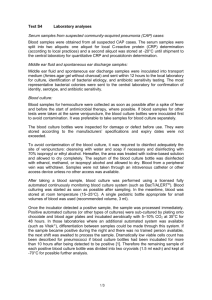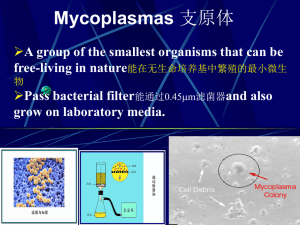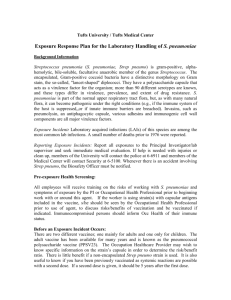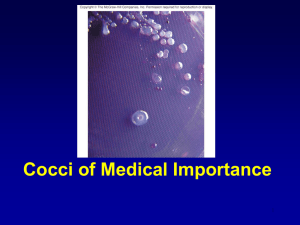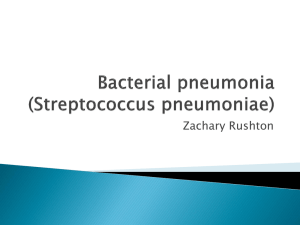ceftriaxone resistance in streptococcus pneumoniae isolated from
advertisement
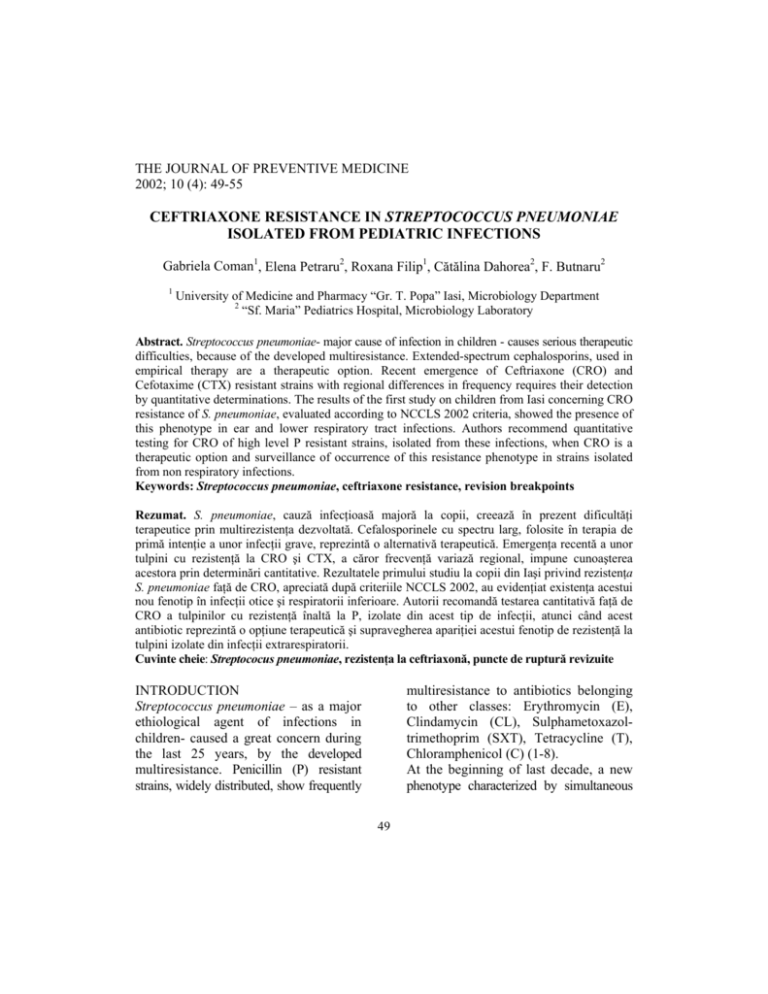
THE JOURNAL OF PREVENTIVE MEDICINE 2002; 10 (4): 49-55 CEFTRIAXONE RESISTANCE IN STREPTOCOCCUS PNEUMONIAE ISOLATED FROM PEDIATRIC INFECTIONS Gabriela Coman1, Elena Petraru2, Roxana Filip1, Cătălina Dahorea2, F. Butnaru2 1 University of Medicine and Pharmacy “Gr. T. Popa” Iasi, Microbiology Department 2 “Sf. Maria” Pediatrics Hospital, Microbiology Laboratory Abstract. Streptococcus pneumoniae- major cause of infection in children - causes serious therapeutic difficulties, because of the developed multiresistance. Extended-spectrum cephalosporins, used in empirical therapy are a therapeutic option. Recent emergence of Ceftriaxone (CRO) and Cefotaxime (CTX) resistant strains with regional differences in frequency requires their detection by quantitative determinations. The results of the first study on children from Iasi concerning CRO resistance of S. pneumoniae, evaluated according to NCCLS 2002 criteria, showed the presence of this phenotype in ear and lower respiratory tract infections. Authors recommend quantitative testing for CRO of high level P resistant strains, isolated from these infections, when CRO is a therapeutic option and surveillance of occurrence of this resistance phenotype in strains isolated from non respiratory infections. Keywords: Streptococcus pneumoniae, ceftriaxone resistance, revision breakpoints Rezumat. S. pneumoniae, cauză infecţioasă majoră la copii, creează în prezent dificultăţi terapeutice prin multirezistenţa dezvoltată. Cefalosporinele cu spectru larg, folosite în terapia de primă intenţie a unor infecţii grave, reprezintă o alternativă terapeutică. Emergenţa recentă a unor tulpini cu rezistenţă la CRO şi CTX, a căror frecvenţă variază regional, impune cunoaşterea acestora prin determinări cantitative. Rezultatele primului studiu la copii din Iaşi privind rezistenţa S. pneumoniae faţă de CRO, apreciată după criteriile NCCLS 2002, au evidenţiat existenţa acestui nou fenotip în infecţii otice şi respiratorii inferioare. Autorii recomandă testarea cantitativă faţă de CRO a tulpinilor cu rezistenţă înaltă la P, izolate din acest tip de infecţii, atunci când acest antibiotic reprezintă o opţiune terapeutică şi supravegherea apariţiei acestui fenotip de rezistenţă la tulpini izolate din infecţii extrarespiratorii. Cuvinte cheie: Streptococus pneumoniae, rezistenţa la ceftriaxonă, puncte de ruptură revizuite multiresistance to antibiotics belonging to other classes: Erythromycin (E), Clindamycin (CL), Sulphametoxazoltrimethoprim (SXT), Tetracycline (T), Chloramphenicol (C) (1-8). At the beginning of last decade, a new phenotype characterized by simultaneous INTRODUCTION Streptococcus pneumoniae – as a major ethiological agent of infections in children- caused a great concern during the last 25 years, by the developed multiresistance. Penicillin (P) resistant strains, widely distributed, show frequently 49 Gabriela Coman, Elena Petraru, Roxana Filip, Catalina Dahorea, F. Butnaru of the results was done according to NCCLS 2001 (15), and compared to NCCLS 2002 (16). As control strain in sensitivity testing was used S. pneumoniae ATCC 49619. resistance to extended spectrum cephalosporins occurred; it caused therapeutic failure in pneumococcal meningitis treated with Cefotaxime (CTX) or Ceftriaxone (CRO) (5,9-11). Frequency and level of resistance to third generation cephalosporins used in the empirical therapy of severe infections show large regional differences (11-14). On the other hand, the exclusive use of quantitative methods in sensitivity testing to these agents is a obstacle in routine assay. The above mentioned conditions, made the motivation of our study, performed on a certain age category of patients. RESULTS Amongst the 46 P resistant strainsevaluated by disk diffusion method- 19 were intermediate resistant, with MIC 0.25- 1.5 µg/ml (fig. 1). For this category of strains, CRO MIC varied between 0.064 and 0.5 µg/ml, being therefore considered sensitive, according to NCCLS criteria, 2001 (15) and also 2002 (table 1) (16). All the 7 strains isolated from blood, cerebrospinal fluid (CSF) and joint fluid belonged to this category. Strains showing high P resistance MIC (2- ≥ 32 µg/ml) had a variable behavior against CRO (table 1). According to NCCLS 2001 criteria (15), 11 strains were considered sensitive (MIC: 0.25- 0.5 µg/ml), 5 with intermediate resistance (MIC: 0.75-1 µg/ml) and 11 high resistance (MIC: 2-12 µg/ml). According to NCCLS 2002 criteria (16), which indicate different breakpoints for strains isolated from meningitis and nonmeningeal infections, the numbers of sensitive (MIC ≤ 1 µg/ml), intermediate (MIC: 1.5- 3 µg/ml) and resistant (MIC ≥ 4 µg/ml) strains become: 16, 7 and 4, respectively (table 1). MATERIAL AND METHODS 46 clinically significant S. pneumoniae strains were included in the study; they were isolated as follows: otitis media (24), lower respiratory tract infections (15), bacteremia (4), meningitis (2) and arthritis (1) from children hospitalized in the Emergency pediatric hospital “Sf.Maria” from Iasi, Romania during January 2001- September 2002. Initially, strains were tested by disk diffusion method against Oxacillin (OX), E, SXT, T, C, Rifampicine (RIF) and they were considered P resistant if the OX inhibition zone diameter was < 20 mm, according to NCCLS 2001 and 2002 (15,16). In the second stage, we determined P and CRO minimal inhibitory concentration (MIC) by E-test (ABBiodisk- Solna Sweden) following the manufacturer instructions; interpretation 50 CEFTRIAXONE RESISTANCE IN STREPTOCOCCUS PNEUMONIAE 10 No.strains 8 6 6 4 4 6 6 3 0 44 22 2 5 5 4 2 2 0 0 0 4 4 4 3 3 1 4 1.5 2 1 11 0 0.064 0.094 0.125 0.19 0.25 0.38 0.5 0.75 P 3 1 1 0 CRO 7 3 4 0 0 6 8 0 00 0 16 24 12 32 MIC (mg/l) Fig. 1 MIC values for Penicillin G (P) and ceftriaxone (CRO) of the 46 S. pneumoniae strains Table 1. Ceftriaxone sensitivity of S. pneumoniae strains intermediate or resistant to Penicillin MIC Penicillin G MIC ceftriaxone* 0.25 - 1.5 µg/ml ≥ 2 µg/ml ≤ 1 µg/ml 19 16 1.5- 3 µg/ml 0 7 ≥ 4 µg/ml 0 4 * Strain classification was done according to NCCLS 2002 criteria. tested by antibiogram. Phenotype P+E+SXT+T was the most frequently encountered both in sensitive and resistant strains (table 2). The CRO hyperresistant strain (MIC = 12 µg/ml) proved to possess the biggest number of resistance determinants (the only strain multiresistant to the 7 tested antibiotics). Majority of strains with modified CRO sensitivity (6 with intermediate resistance and 3 with high resistance) were isolated from children with otitis media; one of these strains showed the highest resistance level to Penicillin (MIC ≥ 32 µg/ml) and CRO (MIC = 12 µg/ml). Strains with different CRO sensitivity haven’t presented a different resistance pattern against 5 non β- lactam antibiotics 51 Gabriela Coman, Elena Petraru, Roxana Filip, Catalina Dahorea, F. Butnaru Table 2. Resistance phenotypes in S. pneumoniae strains CRO* Patterns of resistance sensitive intermediate resistant P+SXT 2 P+E+SXT 3 1 1 P+E+T 1 P+SXT+T 4 P+SXT+RIF 2 P+E+SXT+T 13 6 2 P+E+SXT+T+C 5 P+E+SXT+T+RIF 5 P+E+SXT+T+C+RIF 1 * Strain classification was done according to NCCLS 2002 criteria. better activity (2,5,6,20). According to data from literature, none of CRO or CTX resistant strains was P sensitive, but not all the P resistant strains show modified sensitivity to extended spectrum cephalosporins (4,13). Disk diffusion method is not very accurate in determining the cephalosporin resistance; that is why NCCLS recommends quantitative determinations (10,11,15,16). Among these, E-test is considered a simple method and well correlated with broth dilution technique, taken as reference (21). In 2002, NCCLS (16) changed the breakpoints for CRO and CTX for non meningeal isolates, as the frequency of resistant strains decreased. Sahm et al (22) reported changes in ratio for sensitive, intermediate and resistant strains respectively, from 82.7%, 13.2% and 4.1% to 95.5%, 3.1% and 1%, compared to the new standard. In our DISCUSSION Data from literature mentioned an extremely high frequency in some countries of P resistant S. pneumoniae: 35% in USA (3), 40% in Spain (7), 77% in Korea (17), 67% in Hungary exclusively in pediatric cases (18). In a previous collaboration study undertaken during 1997- 1998 between our hospital and Beer-Sheva University (Israel), we found a frequency of 69% of these strains, some of them with extremely high MIC values (19). These findings proved that, in our region, there were the prerequisites for strains with cephalosporin modified resistance, the relation between increased MICs in cephalosporins and P being well known. Changes in Penicillin Binding Protein (PBP) - basis for βlactam resistance - cause the decrease of the affinity for target of all this group of agents, but third generation cephalosporins and carbapenems are known to have a 52 CEFTRIAXONE RESISTANCE IN STREPTOCOCCUS PNEUMONIAE CONCLUSIONS 1. The results of the first study undertaken in Iasi concerning CRO resistance in S. pneumoniae, detected the new phenotype of strains isolated from otic and lower respiratory tract infections. 2. In this type of infections, when this antibiotic is an option, quantitative CRO testing of high P resistant and multiresistant strains is required. Moreover, the testing of P resistant strains from severe infections, especially in pneumococcal meningitis is required to prevent a therapeutical failure. study, the number of strains with high resistance level decreased from 11 to 4, these being recovered from otitis media and lower respiratory tract infections. NCCLS annually reconsiders the inhibition zone diameters and breakpoints according to microbiological, pharmacokinetic, pharmacodynamics and clinical data, especially in species with gradually changes in antibiotic sensitivity (5,23,24). Changes in CRO and CTX breakpoints for S. pneumoniae were dictated by the discrepancies between in vitro results and good therapeutical response in infections with strains considered resistant, isolated from non meningeal infections (5,10). A similar situation is drafted for P breakpoints, at least for strains isolated from lower respiratory tract infections; there is a proposal that only strains with MIC ≥ 4 µg/ml to be considered resistant (2,5,22,25). Revision of P and CRO breakpoints correlated with clinical relevance will contribute in diminishing Vancomycin usage in pediatric infections. It is well known the simultaneous resistance to nonβ-lactam antibiotics of S. pneumoniae, which creates the same therapeutic difficulties as MRSA. Even if, we couldn’t encounter a different behavior against these agents of CRO sensitive and resistant strains, is underlined the CRO high level resistant strain (MIC = 12 µg/ml) with simultaneous resistance to the other 6 tested antibiotics; Vancomycin can be considered only active antibiotic. REFERENCES 1. Appelbaum PC: Antimicrobial resistance in Streptococcus pneumoniae: An overview. Clin. Infect. Dis., 1992, 15: 77-83. 2. Doern GV: Antimicrobial resistance with Streptococcus pneumoniae in the United States. Sem. Resp. Crit. Care Med., 2000, 21: 273-84 3. Doern GV: Antimicrobial use and the emergence of antimicrobial resistance with Streptococus pneumoniae in the United States. Clin. Infect. Dis., 2000,33 (Suppl 3): S187-92. 4. Friedland IR, Istre GR: Managenent of penicillin-resistant pneumococcal infections. Pediatr Infect Dis J., 1992,11: 433-5. 5. Kaplan SL: Streptococcus pneumoniae: Impact of antibiotic resistance in pediatrics. Curr. Probl. Pediatr., 1997, 27: 187-95. 6. Kihlstrom E, Normann B: Occurrence of pneumococci with resistance or decreased susceptibility to penicillin in Southeast Sweden. Scand. J. Infect. Dis. 1995, 27: 489-94. 53 Gabriela Coman, Elena Petraru, Roxana Filip, Catalina Dahorea, F. Butnaru Serotype distribution, antimicrobial susceptibility, and clinical characteristics. J. Clin. Microbiol., 2001, 39: 733-7. 15. National Committee for Clinical Laboratory standards: Performance standards for antimicrobial susceptibility testing, Eleventh informational supplement. January 2001, 21: 62-3; 102-3. 16. National Committee for Clinical Laboratory standards: Performance standards for antimicrobial susceptibility testing, Twelfth informational supplement. January 2002, 22: 66-7; 114-5. 17. Chong Y, Lee K, Kwon OH, Henrinchsen J: Capsular types and antimicrobial resistance of Streptococcus pneumoniae isolated in Korea, Eur. J. Clin. Microbiol. Infect. Dis., 1995,14: 528-31. 18. Marton A: Pneumococcal antimicrobial resistance: the problem in Hungary. Clin. Infect. Dis., 1992, 15: 106-11. 19. Porat N, Leibovitz E, Dagan R, et al: Molecular typing of Streptococcus pneumoniae in Northeastern Romania: unique clones of S. pneumoniae isolated from children hospitalized for infections and from healthy and human immunodeficiency virus-infected children in the community. J. Infect. Dis., 2000, 181: 966-74. 20. Cohen R, Varon E, Geslin P: Resistance du pneumocoque en pediatrie, Presse Med. 1993, 19: 893-5. 21. Jorgensen JH, Ferraro MJ, McElmeel ML, et al: Detection of penicillin and extended-spectrum cephalosporin resistance among Streptococus pneumoniae clinical isolates by use of the E-test. J. Clin. Microbiol., 1994, 32: 159-63. 22. Sahm DF, Thornsberry C, Mayfield DC, Jones ME, Karlovsky A: In vitro activities of broad-spectrum cephalosporins 7. Linares J, Pallares R, Alonso T, et al: Trends in antimicrobial resistance of clinical isolates of Streptococcus pneumoniae in Bellvitge Hospital, Barcelona, Spain (1979-1990). Clin. Infect. Dis., 1992, 15: 99-105. 8. Tomasz A: Antibiotic resistance in Streptococcus pneumoniae. Clin. Infect. Dis., 1997,24 (Suppl 1): S85-8. 9. Catalan MJ, Fernandez JM, Vazquez A, et al: Failure of cefotaxime in the treatment of meningitis due to relatively resistant Streptococcus pneumoniae, Clin. Infect. Dis., 1994, 18: 766-9. 10. Jorgensen JH, Swenson JM, Tenover FC, et al: Development of interpretive criteria and quality control limits for broth microdilution and disk diffusion antimicrobial susceptibility testing of Streptococcus pneumoniae. J. Clin. Microbiol., 1994, 32: 2448-59. 11. Klugman KP: Pneumococcal resistance to the third-generation cephalosporins: clinical, laboratory and molecular aspects. International J. Antimicrob. Agents, 1994, 4: 63-7. 12. Fiore AE, Moroney JF, Farley MM, et al: Clinical outcomes of meningitis caused by Streptococcus pneumoniae in the era of antibiotic resistance. Clin. Infect. Dis., 2000, 30: 71-7. 13. Butler JC, Hofmann J, Cetron MS, et al: The continued emergence of drug-resistant Streptococcus pneumoniae in the United States: An update from the centers for disease control and prevention’s pneumococal sentinel surveillance system. J. Infect. Dis., 1996, 174: 986-93. 14. Jette LP, Delage G, Ringuette L, et al: Surveillance of invasive Streptococus pneumoniae infection in the province of Quebec, Canada, from 1996 to 1998: 54 CEFTRIAXONE RESISTANCE IN STREPTOCOCCUS PNEUMONIAE against nonmeningeal isolates of Streptococcus pneumoniae: MIC interpretation using NCCLS M100-S12 recomandations. J. Clin. Microbiol., 2002, 40: 669-74. 23. Ferraro MJ: Should we reevaluate antibiotic breakpoints?. Clin. Infect. Dis., 2001, 33 (Suppl 3): S227-9. 24. Phillips I: Reevaluation of antibiotic breakpoints. Clin. Infect. Dis., 2001, 33, (Suppl): S230-2. 25. Bishai W: The in vivo-in vitro paradox in pneumococcal respiratory tract infections. J. Antimicrob. Chemother., 2002, 49: 433-6. 55

